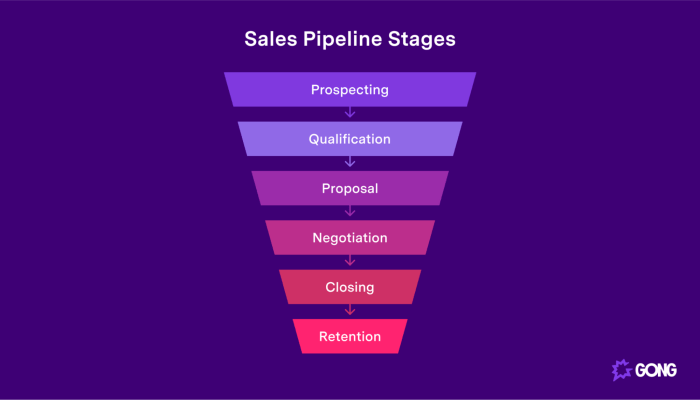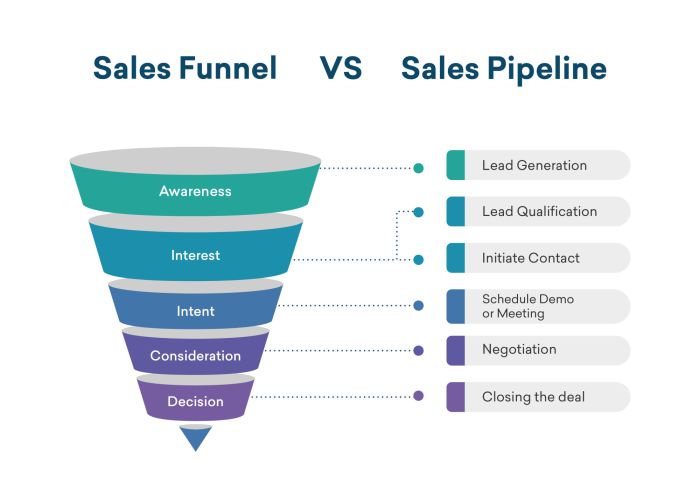Understanding the Sales Pipeline kicks off this journey into the world of sales success. Dive in as we explore key strategies and insights to navigate the sales process with finesse.
From defining the stages of a sales pipeline to leveraging technology for optimal management, this topic covers all you need to know for sales excellence.
Overview of Sales Pipeline
In the world of sales, a sales pipeline is a visual representation of the stages a potential customer goes through before making a purchase. It is a crucial tool for tracking and managing the sales process from start to finish.
Key Stages in a Sales Pipeline
- Prospecting: Identifying potential leads and gathering information about them.
- Qualification: Determining if the lead is a good fit for the product or service.
- Meeting/Discovery: Engaging with the lead to understand their needs and challenges.
- Proposal: Presenting a solution or offer tailored to the lead’s requirements.
- Closing: Finalizing the deal and getting the customer to commit to the purchase.
Benefits of a Well-Defined Sales Pipeline
- Improved Forecasting: Allows businesses to predict future sales more accurately.
- Efficient Resource Allocation: Helps in allocating resources to areas that need more attention.
- Enhanced Customer Relationships: Enables a more personalized and targeted approach to selling.
- Increased Revenue: Leads to higher conversion rates and ultimately more sales.
Sales Pipeline Management

Effective management of the sales pipeline is crucial for maximizing sales opportunities and revenue. By implementing the right strategies, tracking progress at each stage, and leveraging technology, businesses can streamline their sales processes and drive growth.
Strategies for Effective Sales Pipeline Management
- Establish clear criteria for each stage of the sales pipeline to ensure consistency and transparency.
- Regularly review and update your pipeline to identify bottlenecks and address any issues promptly.
- Provide ongoing training and support for your sales team to help them navigate the pipeline efficiently.
- Utilize data analytics to gain insights into customer behavior and trends, enabling you to make informed decisions.
Tracking and Analyzing Progress
Tracking and analyzing progress at each stage of the sales pipeline is essential for optimizing performance and identifying areas for improvement.
- Utilize CRM software to monitor leads, opportunities, and deals in real-time.
- Set key performance indicators (KPIs) to measure success and track progress towards sales goals.
- Regularly review sales reports and metrics to identify trends, patterns, and potential challenges.
Role of Technology in Optimizing Sales Pipeline Management
Technology plays a critical role in optimizing sales pipeline management by providing tools and resources to streamline processes and enhance efficiency.
- Implement automation tools to streamline repetitive tasks and workflows, saving time and increasing productivity.
- Utilize AI and machine learning algorithms to analyze data and provide actionable insights for better decision-making.
- Integrate communication tools to facilitate collaboration and communication within the sales team, improving coordination and efficiency.
Understanding Customer Journey

When it comes to understanding the customer journey, it’s all about recognizing the steps a potential customer takes from the initial awareness of a product or service to making a purchase. This journey is crucial for businesses to comprehend in order to effectively guide customers through the sales pipeline.
Mapping the customer journey can greatly improve the sales pipeline by providing insights into customer behavior, preferences, and pain points at each stage of the journey. This information allows businesses to tailor their sales strategies and messaging to better meet the needs of customers, ultimately increasing conversions and sales.
Aligning Sales Pipeline Stages with Customer Needs and Behaviors, Understanding the Sales Pipeline
One way to align sales pipeline stages with customer needs and behaviors is by understanding the specific actions and decisions customers make at each stage of the journey. By identifying these key touchpoints, businesses can create targeted sales strategies that address customer concerns and provide solutions that resonate with their needs.
- Identify Customer Pain Points: By understanding what challenges customers face at each stage of the journey, businesses can tailor their sales approach to address these pain points effectively.
- Personalize Communication: Utilize customer data and insights to personalize communication and offer relevant solutions that align with customer preferences.
- Adapt Sales Process: Be flexible in adapting the sales process to accommodate different customer behaviors and preferences, ensuring a seamless experience throughout the customer journey.
- Measure and Analyze: Continuously monitor and analyze customer interactions to refine the sales pipeline stages and improve overall customer experience.
Sales Pipeline Metrics: Understanding The Sales Pipeline
When it comes to measuring the performance of a sales pipeline, there are key metrics that can provide valuable insights into the effectiveness of your sales process. By analyzing these metrics, sales teams can make informed decisions to optimize their strategies and increase conversion rates.
Conversion Rate
The conversion rate is a crucial metric that measures the percentage of leads that progress through each stage of the sales pipeline. By tracking the conversion rate at each stage, sales teams can identify bottlenecks and areas for improvement in the sales process.
Sales Velocity
Sales velocity measures the speed at which leads move through the sales pipeline. It takes into account the time it takes for a lead to progress from one stage to another. By analyzing sales velocity, sales teams can identify areas where the sales process is slowing down and take steps to streamline it.
Win Rate
The win rate measures the percentage of deals that are successfully closed. By tracking the win rate, sales teams can evaluate the effectiveness of their sales strategies and identify opportunities for improvement. Adjusting sales tactics based on win rate can help optimize the sales pipeline and increase overall sales performance.